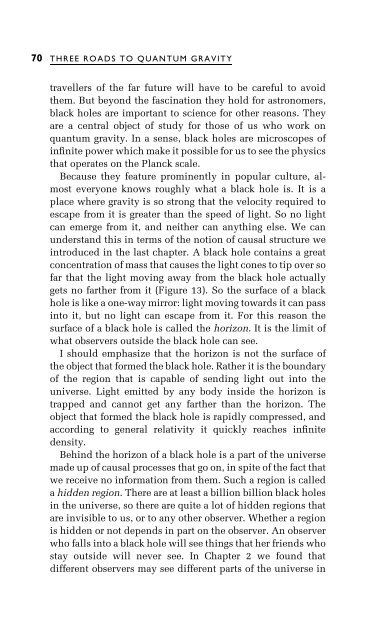Three Roads To Quantum Gravity
Three Roads To Quantum Gravity
Three Roads To Quantum Gravity
Create successful ePaper yourself
Turn your PDF publications into a flip-book with our unique Google optimized e-Paper software.
70 THREE ROADS TO QUANTUM GRAVITY<br />
travellers of the far future will have to be careful to avoid<br />
them. But beyond the fascination they hold for astronomers,<br />
black holes are important to science for other reasons. They<br />
are a central object of study for those of us who work on<br />
quantum gravity. In a sense, black holes are microscopes of<br />
in®nite power which make it possible for us to see the physics<br />
that operates on the Planck scale.<br />
Because they feature prominently in popular culture, almost<br />
everyone knows roughly what a black hole is. It is a<br />
place where gravity is so strong that the velocity required to<br />
escape from it is greater than the speed of light. So no light<br />
can emerge from it, and neither can anything else. We can<br />
understand this in terms of the notion of causal structure we<br />
introduced in the last chapter. A black hole contains a great<br />
concentration of mass that causes the light cones to tip over so<br />
far that the light moving away from the black hole actually<br />
gets no farther from it (Figure 13). So the surface of a black<br />
hole is like a one-way mirror: light moving towards it can pass<br />
into it, but no light can escape from it. For this reason the<br />
surface of a black hole is called the horizon. It is the limit of<br />
what observers outside the black hole can see.<br />
I should emphasize that the horizon is not the surface of<br />
the object that formed the black hole. Rather it is the boundary<br />
of the region that is capable of sending light out into the<br />
universe. Light emitted by any body inside the horizon is<br />
trapped and cannot get any farther than the horizon. The<br />
object that formed the black hole is rapidly compressed, and<br />
according to general relativity it quickly reaches in®nite<br />
density.<br />
Behind the horizon of a black hole is a part of the universe<br />
made up of causal processes that go on, in spite of the fact that<br />
we receive no information from them. Such a region is called<br />
a hidden region. There are at least a billion billion black holes<br />
in the universe, so there are quite a lot of hidden regions that<br />
are invisible to us, or to any other observer. Whether a region<br />
is hidden or not depends in part on the observer. An observer<br />
who falls into a black hole will see things that her friends who<br />
stay outside will never see. In Chapter 2 we found that<br />
different observers may see different parts of the universe in



![arXiv:1001.0993v1 [hep-ph] 6 Jan 2010](https://img.yumpu.com/51282177/1/190x245/arxiv10010993v1-hep-ph-6-jan-2010.jpg?quality=85)


![arXiv:1008.3907v2 [astro-ph.CO] 1 Nov 2011](https://img.yumpu.com/48909562/1/190x245/arxiv10083907v2-astro-phco-1-nov-2011.jpg?quality=85)








![arXiv:1002.4928v1 [gr-qc] 26 Feb 2010](https://img.yumpu.com/41209516/1/190x245/arxiv10024928v1-gr-qc-26-feb-2010.jpg?quality=85)
![arXiv:1206.2653v1 [astro-ph.CO] 12 Jun 2012](https://img.yumpu.com/39510078/1/190x245/arxiv12062653v1-astro-phco-12-jun-2012.jpg?quality=85)
